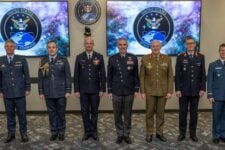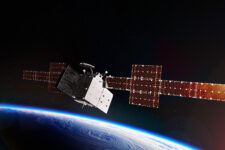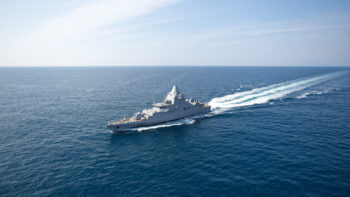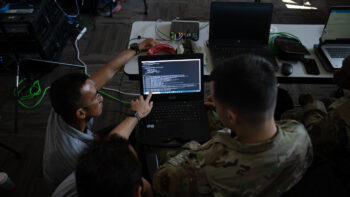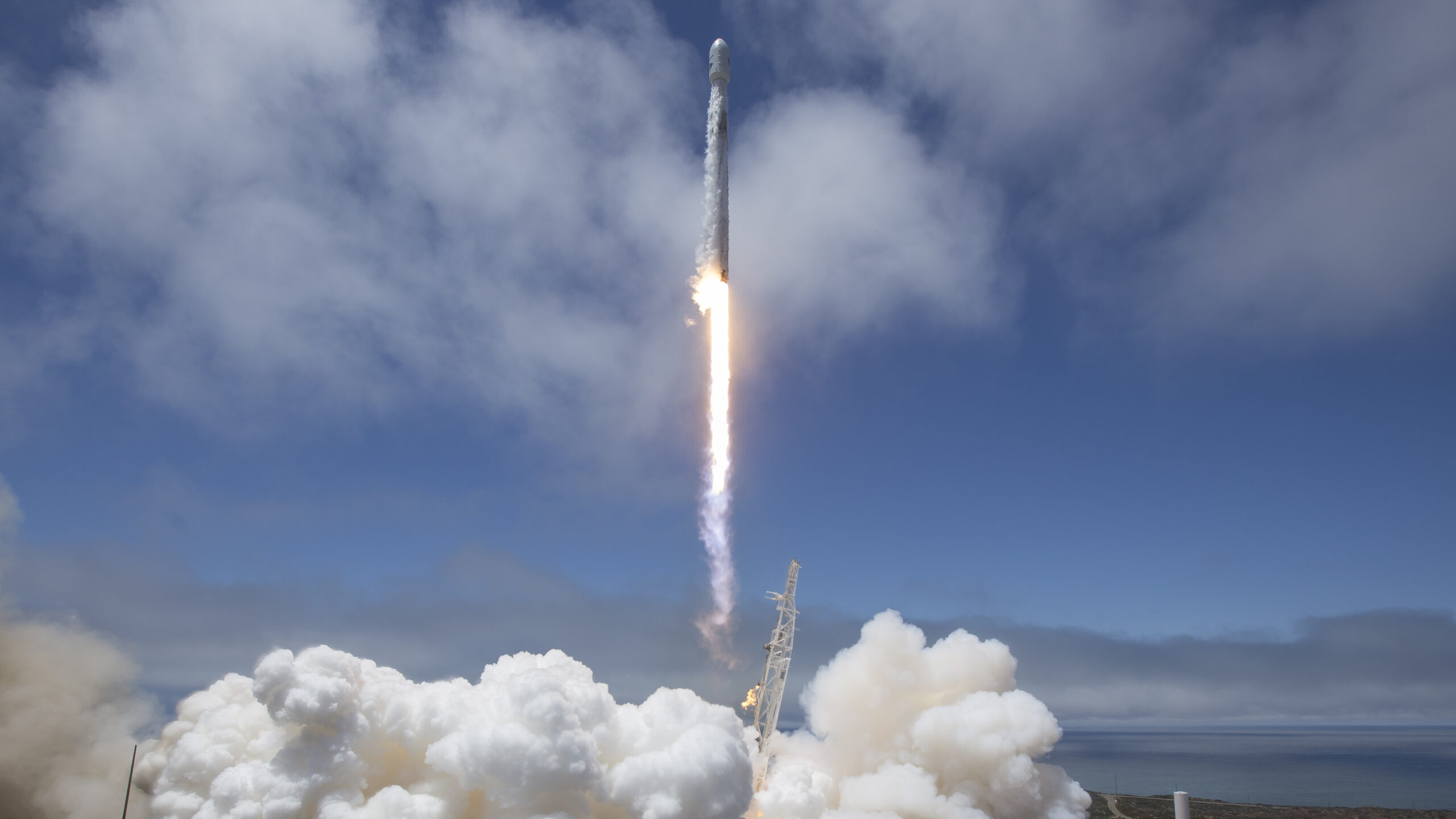
In this handout image provided by NASA, the NASA/German Research Centre for Geosciences GRACE Follow-On spacecraft launch onboard a SpaceX Falcon 9 rocket, Tuesday, May 22, 2018, from Space Launch Complex 4E at Vandenberg Air Force Base in California. (Photo by Bill Ingalls/NASA via Getty Images)
WASHINGTON: The National Reconnaissance Office will kick off its launch manifest for 2022 Wednesday (if all systems, including weather, are deemed ‘go’), with SpaceX using a Falcon 9 to loft a classified payload from Vandenberg Space Force Base, Calif.
NRO historically has launched from Vandenberg in California and Cape Canaveral Station in Florida. In 2020, it for the first time launched a spy satellite from foreign soil, putting up NROL-151 into LEO on a Rocket Lab Electron booster from New Zealand’s Mahia Peninsula.
But Col. Chad Davis, NRO’s director of the Office of Space Launch, told reporters Monday in response to a question from Breaking Defense that the spy agency is planning to use a space launch facility on a “third continent” for one the seven launches it has planned for this year.
“The launch environment — the manifest and scheduling — is an incredibly dynamic and fluid activity that changes on a near-daily basis. If you ask my executive assistant she’ll tell you,” he said with a laugh. “We’re looking at something like a half a dozen for the calendar year and then deploying 12 payloads. If I take a snapshot today, that number is seven launches in eight months — from three different continents.”
Just where that new spaceport might be is a bit of a mystery. Obviously, the US launch facilities are based in North America. New Zealand technically isn’t part of the Australian continent, but is close enough for rock and roll — often designated as part of Oceania along with Australia and the islands of Melanesia, Micronesia and Polynesia. That leaves five other continents to choose from: Africa, Antarctica, Asia, Europe and South America.
An NRO spokesperson issued, in effect, a no comment when asked directly to where Davis was referring. “We have a busy launch year planned and we’re happy to offer a big picture look at our plans, but are not in a position to offer further specifics at this time,” the spokesperson told Breaking Defense.
The other mystery is just what capabilities Wednesday’s NROL-87 mission is carrying. NRO never talks about its payloads, period.

NRO plans to launch the NROL-87 mission into LEO on a SpaceX Falcon 9 on Feb. 2, 2021. (NRO)
“I cannot provide, unfortunately, really any details whatsoever in this environment, which is really frustrating to me in one regard because then I’m not I’m not able to accurately communicate the kind of capability this is going to deliver on orbit,” Davis said.
NRO develops and operates electro-optical and radar imaging satellites, as well as signals-gathering satellites. Wednesday’s planned launch is going to an orbit of about 500km in altitude, which is typical for an imaging satellite.
UK A Potential Launch Partner, As London Beefs Up Military Space Efforts
One possibility for the mystery launch site is the United Kingdom. Not one, not two but three commercial spaceports are set to begin operations this year on UK soil, all with funding from the UK Space Agency (UKSA). Two of the three, Space Hub Sutherland in Scotland and Saxa Vord Spaceport in the Shetland Islands, will host traditional rockets that launch vertically. The third, Space Port Cornwall, is being specifically designed for use by UK firm Virgin Orbit and will provide capability for horizontal launch (i.e., spacecraft launched from airplanes). All three will be limited to launching small to mid-sized satellites to LEO.
Further, the UK today released its first, long-awaited military space strategy today, confirming the Ministry of Defense’s earlier pledge to invest 1.4 billion British pounds ($1.9 billion) over the next 10 years in space activities. It will be managed MoD’s new Space Command, stood up in July and headquartered at RAF High Wycombe, a Royal Air Force base some 28 miles west of London.
While the strategy, called Defence Space Strategy: Operationalising the Space Domain, explains that the British government doesn’t intend to fund a national security launch program, it does stress MoD’s support for the emerging commercial launch sector. “Though we will not develop our own independent launch systems, we will continue to support the UKSA in the advancement of UK-based space launch activities, both vertical and horizontal, and work closely with our allies and partners to assure appropriate and timely access to space.”
Indeed, Space News today reported that during the UK government press conference on the new strategy, Air Vice-Marshal Paul Godfrey, commander of UK Space Command, said the command will host an industry day March 30 to discuss collaboration, including on responsive launch. “We were in the US last week talking about responsive launch,” said Godfrey.
The UK also is a signatory to US Space Command’s Operation Olympic Defender plan for coalition warfighting to protect and defend satellites in a conflict.
Further, Washington and London in June 2020 signed UK-US Technology Safeguards Agreement (TSA) enabling US companies to operate from UK spaceports and export space launch technology. It also provides safeguards that US tech is protected, while allowing UK companies access.
On the other hand, close US allies France, Japan and Israel also have independent space launch capabilities, as does the European Space Agency (which uses the launch facilities in French Guiana, South America). India, too, is a launching state. France, as Breaking Defense has reported, has expressed interest in the past in joining Operation Olympic Defender and has a robust military space program.
NROL-87’s ‘Firsts’
NROL-87 is itself a first-of-a-kind launch in two ways. It will be the first NRO launch to use a Falcon 9 booster that subsequently will be re-used for other agency launches, NRO officials explained during the press briefing.
NROL-87 also will be the first NRO launch to use SpaceX under the Space Force’s National Security Space Launch (NSSL) program. While NRO has contracted SpaceX and Falcon 9 for previous launches, those have been through direct commercial contracts rather than through NSSL.
ULA and SpaceX nabbed the hard-fought NSSL phase 2 awards in 2020, each with a first contract to cover launches through 2024.
Davis said that the mix of commercial and NSSL contracts used by NRO is determined on a case-by- case basis.
“We really let the mission and the acquisition approach guide us to the right launch solution for that particular mission,” he said, “because there’s so many variables in each in each of these missions.” Those can include, he elaborated, costs and scheduling demands. “It’s just really tough to talk specifically about about that because every mission is so unique.”
Space Force expects first space reserve contracts by year end
Col. Rich Kniseley, who heads up the Space Force’s Commercial Space Office, said right now he is “targeting mainly space domain awareness” for the first CASR contracts.


